All profits to

Archive Home Page
Previous Exhibition Following Exhibition
Powick Parish Hall, 56 Malvern Road, Powick, Worcester, WR2 4RT
All profits to |  |
This exhibition raised £1,362 for St Richard's Hospice. Thank you to everyone who attended.
Descriptions are based on material supplied by the layout owners
Badger's Yard Badger's Yard is typical of many small rail yards around the country that served industry with a once thriving railway system. Surrounded by housing and industry, the yard is now very run down and used for assembling wagons to be forwarded to local customers. The layout is based on an Inglenook shunting puzzle with 3 sidings and a head shunt. A main line has been added so the wagons can be removed when they're sorted. The idea is to assemble 5 of the 8 wagons on the layout into set order using the smallest number of moves. The track is Peco code 75, points are fitted with Seep motors, the stock is fitted with DG coupling and uncoupling is done with electro-magnets. The locomotives are DCC controlled, points and magnets are operated by a switch panel. | 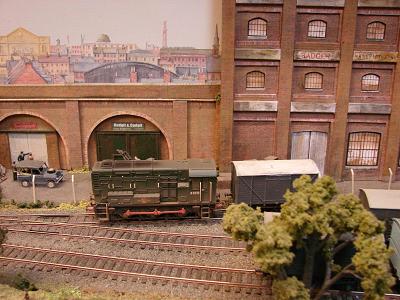 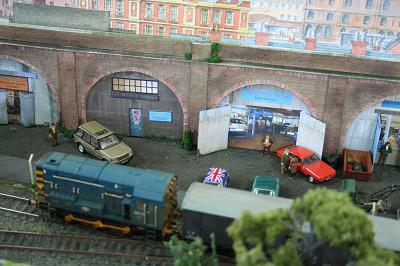 | |
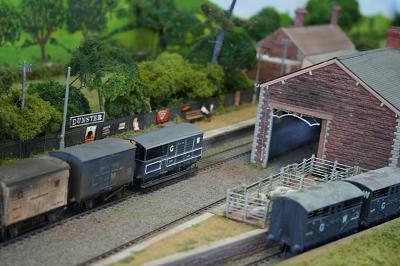 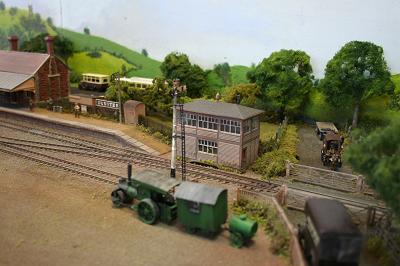 |
Dunster is a station on the now preserved GWR line to Minehead. It represents a basic branch line station in the 1930's-40's era. The station building is perhaps more elaborate than usual as this station served nearby Dunster Castle. Dukes and Maharajahs were visitors during the inter war years and polo was a very popular pastime. Horse boxes would have been regularly seen carrying the polo ponies. The station building and signal box are modified Hornby kits. The track is Peco finescale code 75 and the signals are Ratio operated by Fulgurex motors. The stock is a mixture of proprietary and kit built. | |
Llanthony Road Llanthony Road is loosely based on Gloucester docks and its environs. The buildings are based on prototypes found at the docks and around Llanthony Road. The docks traffic ceased in approximately 1989. It was served by the former Great Western Railway Docks branch over the river Severn and across Llanthony Road to Llanthony yard opposite Bakers Quay. In the seventies and eighties the freight traffic was mainly flour, seed and cement. I have imagined that the branch survived albeit in a mothballed state through to the present day. As trains arrive on the layout from the right hand side they pass under a former seed and flourmill conveyor. I have taken this end of the layout to be the connection with the former Great Western docks branch from Over. The line passes an old engineering works that now repairs railway wagons and across the level crossing, passing the Tall Ship public house. On the left is the mariner‘s chapel (1849) from the docks and next to that the lock warehouse (1834) which is now Gloucester Antiques Centre. Towards the middle of the layout a siding branches off alongside a wharf similar to that found at Victoria Dock. Behind a permanent way compound is a collection of semi—dereIict buildings representing Foster Bros. oilseed and cake mill (1862) which was alongside Bakers Quay. At the far end of the layout the line crosses the end of a spur to a disused canal basin and crosses Llanthony Road past the lift bridge and the Llanthony Yard office. On the near side of the canal are the bridge control cabin and a collection of shops. |  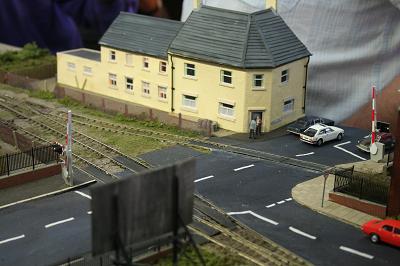 | |
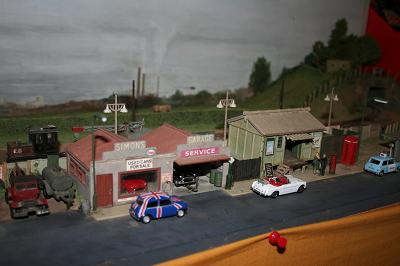 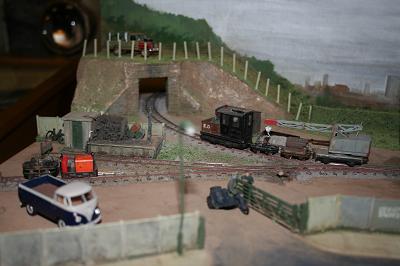 |
The first Mark layout was in existence for some twenty years and was showing its age, so it was decided that the time was right to build Mark II. The track plan is similar, with the addition of a siding for loco coal and water. The station area uses most of the buildings off the original layout and these are nearly all concrete structures, as are the platform, fencing and lamp posts. The period is set in the fifties and the locos and rolling stock are a rather motley collection. There is a steam engine for passenger trains, a diesel for freight and ED the engineering department engine. | |
North Bridge Northbridge is the fictitious location set on the old Westbridge branch in Leicester and is where trains from Coalville and Burton on Trent terminated. The period modelled is the early 1960s and the infrastructure is based on but not a copy of what might have been there. For operating purposes the passenger service still exists and an additional Push Pull service has been invented from Leicester London Road. The goods yard at Westbridge was in reality very much larger and even in the mid 1960's was still quite busy with coal, oil and general traffic and suitable trains are run to incorporate this. The trackwork is Peco code 100 with small radius electrofrog points and is DCC operated. Rolling stock is a mixture of propriety products, some modified and all weathered to some degree and indicative of what might have been seen in the area had the bore of Glenfield Tunnel been more generous. Many of the buildings are from the Metcalfe range, all altered in some way to fit the location. The overall size of the layout is 260mm x 430mm and folds in half to form a box 350mm deep, it has been an exercise to see how much can be achieved in a small space. | 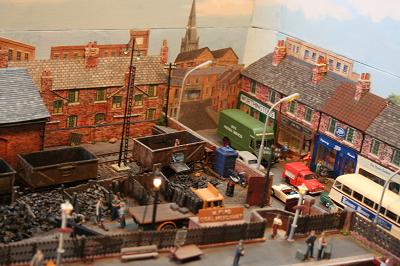 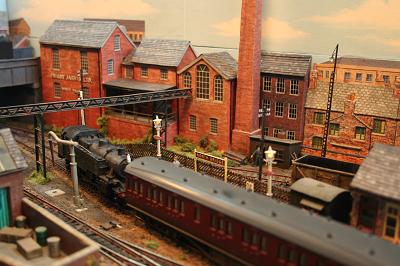 | |
 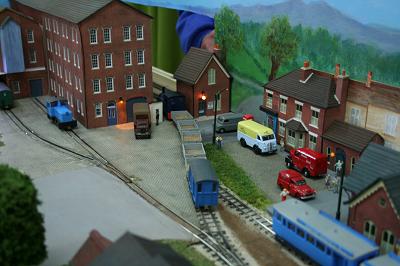 |
| |
Plank Lane The North Eastern Railway, N.E.R. opened its engine shed at Ferryhill, County Durham in 1881 to house a dozen or so goods engines, the allocation had risen to about twenty by the time of the Grouping in 1923. Two class G5 0-4-4 tank engines were added but numbers remained fairly consistent until 1935. At this point Ferryhill was given the allocation of motive power displaced by the closure of Shildon shed, however it only survived for two more years before closure. Ferryhill enjoyed a brief claim to fame during World War Two, when exhibits from the National Railway Museum at York were sent for safe keeping. For my modelling purposes there was, of course, a second, but completely fictitious, locomotive shed at Ferryhill, called Plank Lane. This shed was built on a site originally occupied by the York, Newcastle and Berwick Railway which was taken over by the N.E.R in 1854. The depot being retained and enlarged to house freight locomotives used to service the coalfields of County Durham and North Yorkshire. Unlike its counterpart, Plank Lane survived much longer, mainly due to its location in the triangle formed by the lines to Stockton and Darlington that gave better access to diverging routes. When the locomotives allocation increased at Plank Lane, it was decided to provide a turntable. Land was acquired in 1937 and by late 1938 a 70 foot vacuum tractor turntable had been installed. Plank Lanes reasonable proximity with Darlington works, to the south meant that it could also be used by locomotives on running in turns after attention at the works, therefore allowing a variety of motive power to be seen visiting the depot for checking and servicing before returning to the works. The scene you see is set around 1946 when the LNER was embarking on a renumbering scheme. Some locomotives can be seen newly re-numbered while others awaited such attention. The shed roof was damaged by fire and has been removed awaiting replacement, while other parts of the depot have recovered a little from wartime austerity. |  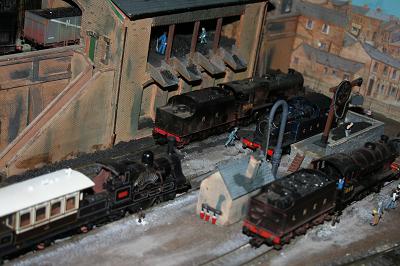 | |
  |
Set in the coal-mining region of the Appalachians the layout represents scenes from the last decade or so on what is now the Norfolk Southern (NS) railroad. The NS was the result of a merger between the Norfolk and Western and Southern railroads. The Southern was noted for the efficiency of its operations and the N&W for its coal hauling. The mine on the upper level is typical of an older type of unit during the last days of its life loading bottom discharge hopper cars bound for the few industries that still need this type of unloading. The cars are taken from the mine and eventually reach an interchange with the main tracks on the lower level. On the lower level can be seen the modern unit coal trains which need rotary tipplers to empty them as they do not have doors on the bottom. These cars run in long block trains from the mines to the power stations or other big users. Others trains to be seen include wood chips in very large gondolas,roadrailers, manifests (mixed), intermodaT and MoW (engineers) trains. Red River featured in the January and February 2005 editions of 'Continental Modeller' and has been shown at Banbury (NScaleUK), Lydney, Ross (NMRA), Chippenham (Trainwest), Caine, Andover (Modelex 2005), Rhondda (S. Wales Model Show), Cheltenham, Abingdon, Alton, TOlworth, High Wycombe, Warley (NEC), Rail-Ex Southwest (Taunton), Derby and Truro (Three Spires Railex). | |
Shunting Puzzle | 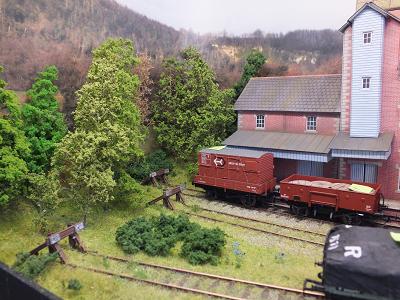 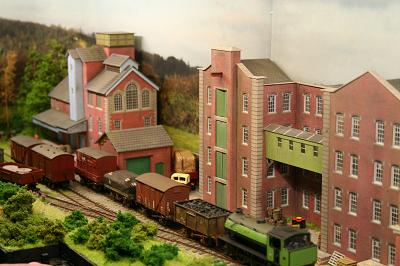 | |
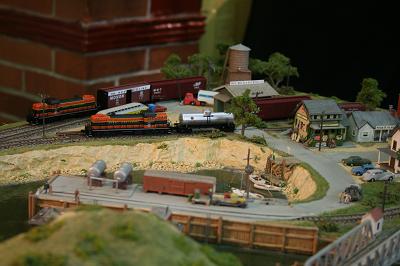 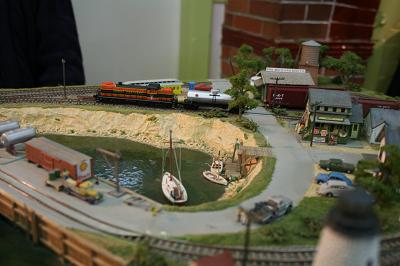 |
| |
Syreford The Cheltenham & Cotswold Hills Railway company was proposed in 1811, to carry the products of the Stone Pipe Company fron Lower Guiting, to a junction with the Leckhampton branch to the horse-drawn Gloucester & Cheltenham Tramway and from thence, to Gloucester Docks. The act of parliament for the 3 ft 6 inches plateway failed at its third reading in May 1812 and the Stone Pipe Company also failed soon after, when installed systems in London and Manchester would not hold water! Syreford Station is the upper terminus of the viable part of line, had it been built for him and survived the Stone Pipe company's failure. The line has been converted to a conventional, locomotive drawn, 2 ft 4 inches gauge railway and is depicted in the early 1950's, when tourism is becoming a significant proportion of the remunerative traffic Track is hand built, using Nickel Silver Code 80 Rail and copper-clad sleeper strip. Buildings are a mixture of textured Das Pronto on plywood shells and scribed styrene sheet. Scenery is carved from a polystyrene blocks, coated with Artex and covered with commercial scatter materials, mostly from the Green Scene range, to simulate a vegetation. All the trees are home-made using twisted wire frames and Woodland Scenics foliage. The backscene is hand painted and is a view of Sandhurst Hill as seen from Sandhurst village near Gloucester. Locomotives and rolling stock are a mixture of scratch-built and kit-built vehicles, some with modified proprietary components. Passenger coaches are, at present, from the Peco range, while the larger proportion of freight wagons are from Wrightlines. The rest are scratch-built from styrene sheet. Locomotives are of various parentage; scratch built, modified proprietary, kit built and a variety of permutations, many improved with DS10 or Mashima Motors, two stage gearboxes and flywheels. All of the models on the layout, with the exception of the Platelayer's hut, have one thing in common and that it is that they are all based on a prototype, however loosely! | 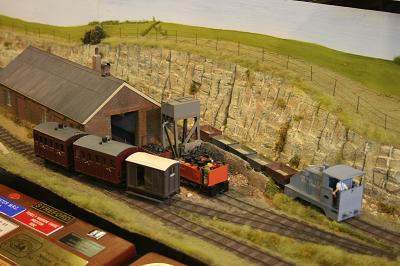  | |
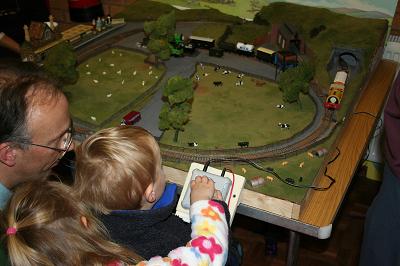 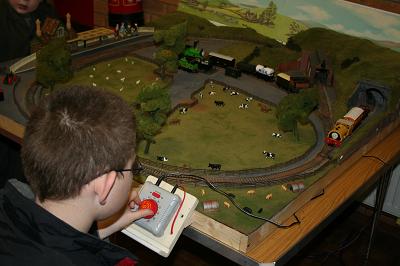 |
We would like to thank Trevor Hallam for looking after the Thomas Layout for many years at our exhibitions and also for refurbishing it at his expense. Unfortunately because of ill health Trevor is no longer able to continue so it was decided to offer Thomas free of charge to Hucclecote Railway Modellers on condition they bring it to all of our future exhibitions. This is the model railway where Children can become Engine Drivers on the Island of Sodor and has of course been inspired by the Reverend Audrey books. Our Thomas and Friends layout has been built for ten years now and in that time we hope it has encouraged many new railway enthusiasts to build a train set of their own. Originally it was intended as a space filler at shows so needed to be small, easy to transport and have a simple track plan, easy for small children to operate. After its first appearance it was clear this model railway would have to be included at all our exhibitions. It incorporates a tunnel, station, level crossing together with locomotive and goods facilities. Train drivers should look out for many of the popular characters; Henry, Percy, Toby, Cranky, the Troublesome Trucks, not forgetting the Sir Topham Hatt better known as the Fat Controller. The famous anthropomorphised rolling stock is mostly from the Thomas range and we are sure most of the adults and all the kids will love it. Happy Driving, but please observe the track speed limits. | |
Upton This layout was inspired by the track plan of Upton-on-Severn. It is set in the years immediately following nationalisation, hence it is possible to run stock in liveries representing both pre and post nationalisation, in the form of the block lettering and also the lion and wheel emblem. Most of the rolling stock is kit built. The trains run depict the type of traffic which might have run through Upton-on-Severn between 1935-1955. My one departure from this theme is to run a Derby lightweight single car D.M.U to portray 1955. Railway services were lost between Malvern and Upton in 1952. At the same time services between Upton and Ashchurch were run on the down line only, although the up line remained in situ. I choose to ignore history and run both up and down lines. |  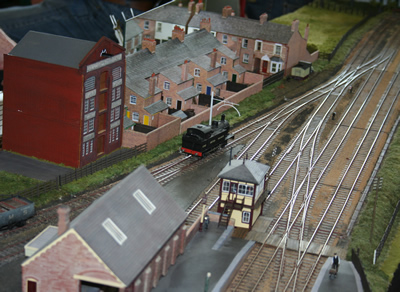 | |
| Displays | ||
South Downs bus rally & vintage show | Model Fairground . | |
Gauge O Guild (Worcestershire Group) | ||
| Modelling Demonstrations | ||
| Mark Begley | Richard Bucknall | |
| Trade | ||
| Amberly Services | Castle Trains WEBSITE | |
| Elite Baseboards WEBSITE | Penduke Models WEBSITE | |
| RCSW (Pre-owned) Models, Clive Reid | Rly books, timetables, photos, Stewart Blencowe WEBSITE | |